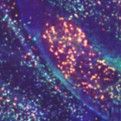
NEURAL CIRCUITS FOR MOVEMENT
Discovering the molecular, cellular, and circuit mechanisms that underlie innate and learned motor actions
OUR RESEARCH
The McElvain lab is part of the Neurobiology Section of the Department of Biological Sciences at USC. We investigate the circuit mechanisms of movement using multidisciplinary approaches, including in vitro and in vivo electrophysiology, viral circuit mapping and perturbation, neuroanatomy, high-resolution animal behavior, and computational modeling.
Everyday life requires remarkably diverse motor actions, ranging from fine movements of our hands and face to whole-body actions. This broad motor repertoire depends on the coordinated activity of neurons across the motor system hierarchy, such that even the simplest motor actions require signaling between many brain regions. Research in our lab aims to delineate how lower levels of the motor system are directed by higher-order controllers during volitional and reflexive movements.
BASAL GANGLIA CONTROL OF MOVEMENT
The basal ganglia are a network of subcortical nuclei that play a central role in regulating behavior and movement. Our lab is interested in identifying how signals leaving the basal ganglia impact downstream motor circuits to influence innate and learned movements. We focus on the largest basal ganglia output nucleus, the substantia nigra pars reticulata (SNr). Projection neurons in SNr form several discrete modules that are each situated to control multiple levels of the motor system hierarchy with high specificity (McElvain et al. 2021).
Our research addresses key questions about SNr function, including: How do SNr cell types map onto specific types of motor actions? How do the broadly collateralized projections from SNr mediate highly specific effects on movement? How does aberrant firing in SNr contribute to specific motor symptoms of Parkinson’s disease and Tourette syndrome?

PREMOTOR CIRCUITS IN THE BRAINSTEM
Most regions of the motor system do not contact motor neurons directly, but rather connect to them via intermediary neuronal populations. The neurons that directly connect to motor neurons, called “premotor neurons”, are predominantly located in the brainstem and spinal cord (McElvain et al. 2010; McElvain et al. 2018; and Chen, McElvain et al. 2019). Premotor neurons form the basic building blocks of movement and orchestrate the diverse effects of higher motor controllers. Our lab is investigating the organization and function of motor circuits with a “bottom-up” view that aims to parcellate brainstem premotor circuits, delineate their behavioral modules, and identify the circuit mechanisms by which higher controllers, including the basal ganglia, engage them to sculpt behavior.

EXPERIMENTAL APPROACHES

IN VITRO ELECTROPHYSIOLOGY
We perform whole-cell patch clamp recordings from neurons in the basal ganglia and brainstem to assess the cellular and synaptic mechanisms of movement.

BEHAVIORAL ASSAYS
We combine high-speed videography, inertial sensors, and EMG recordings to track movement kinematics.

IN VIVO ELECTROPHYSIOLOGY
We record from neurons and muscles in vivo using high-density arrays and electromyographic (EMG) recordings to track how activity develops during behavior.

NEUROANATOMY
We use high-throughput imaging and computational approaches to map and reconstruct connectivity across the motor system hierarchy.

CIRCUIT PERTURBATIONS
We use viral tools to ablate or transiently alter activity in identified populations of neurons to test their effects on motor behaviors.

GENE EXPRESSION ASSAYS
We apply single-cell genomics tools and multiplexed fluorescent in situs to identify and characterize neuronal classes.